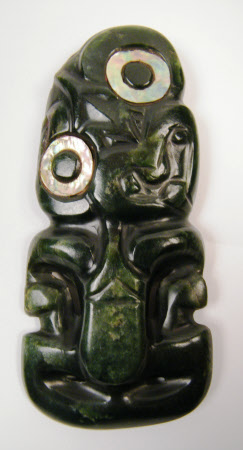Amulet
Category
Ethnographic material
Date
Unknown
Materials
Greenstone
Measurements
153 x 70 x 20 mm
Place of origin
New Zealand
Order this imageCollection
Clandon Park, Surrey
NT 1441301
Caption
Known as a hei-tiki figure, this greenstone pendant is an example of a treasured Māori heirloom that would be passed down through families as a sign of respect. The pendant was brought to England from New Zealand by William Hillier, 4th Earl of Onslow (1853–1911), the owner of Clandon Park. Hillier served as the governor or Crown representative in New Zealand between 1889 and 1892, where his son Huia (1890–1922), was born and named after Ngāti Huia, a Māori sub-tribal grouping. It is possible that this pendant was among a range of gifts presented to Huia Onslow, including a feather cloak and ‘greenstone’. As representations of ancestral humans or spirit forms, hei-tiki are suspended from the neck and absorb the mauri (life force) of their owners as they are worn. Hei-tiki play a key part in Māori death rituals and are placed near the body of the deceased as a spiritual connection between living, dead and past ancestors. This example is one of the few Māori items that survived the fire at Clandon Park in 2014 and represents the enduring colonial connections between the Onslow family and New Zealand.
Summary
[Salvaged] New Zealand nephrite jade hei tiki (amulet), 19th century. Dark green nephrite jade in the form of a human figure, head to the right, hands on hips. Unknown Māori carver. Detailed carving over face and body. Carved eye sockets are missing the haliotis-shells (paua) after salvage from the Clandon Park fire of 2015. Worn hole and some modelling on the back. Brought to Clandon from New Zealand by the 4th Earl of Onslow.
Full description
Nephrite jade from New Zealand is called pounamu or greenstone, and this stylised pendant is a hei tiki figure. Hei means ‘suspended from the neck’, tiki means ‘human figure’. Hei tikis are taonga Māori, or precious Māori family heirlooms that are passed down through ancestral lines, with their power amplifying through continued associations with important individuals. William Hillier, the 4th Earl of Onslow (1853–1911), brought this hei tiki to England from New Zealand after his term as governor, or Crown representative, ended in 1892. One historic photograph (Te Papa photograph 360821) of the 4th Earl’s baby son, Huia Onslow (1890–1922), shows him wearing cloaks with huia bird feathers in his hair and holding a pounamu kapehu in his hand. These were thought to be Māori gifts given to him for his baptism. There is no photographic evidence of Huia Onslow with the hei tiki, but it is possible that this hei tiki is one of the original gifts from the Ngāti Huia community (hapū) to Hillier’s son. It could also have been acquired by another member of the Onslow family while in New Zealand.
Provenance
Accepted by the Treasury in lieu of Estate Duty on the death of the 5th and the 6th Earl in 1984
